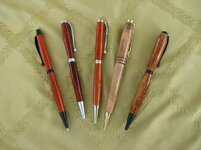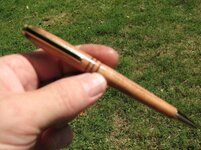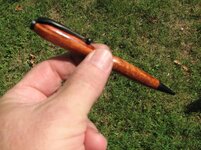Everyone has their own varient, but since I recently took this journey, I cant help but jump in with mine. When starting I read all the articles and wartched the videos. Bottom line is that there is a lot of very subtle technique that casues variations and the method needs to be adapted to you. One person may apply more pressure, another go back and forth slower/faster, different brand of towels, etc. With that said, here is my method. Took a while to practice and adapt and get there. A number of pens were made where I took off all the CA and started over (multiple times in some cases) as I learned.
I eventually gave up on Med CA even though some tuts and videos say it is easier (not for me). I was always getting really thick ridges, and cleaning them up casued sand through.
Pre-finishing (on real pouruos or open grain wood you may need to do this process more than once)
1) Sand to 800 or 1000 depending on my mood/the wood
2) Apply 1 good heavy coat of thin CA.
3) Sand the CA with 600 or 800 (depending on how rough it looks) up though 1000
Now applying CA for finish coats. I use bounty - just becasue a 12 roll pack was on sale at home depot when I started this journey, and I haven't used it all up yet. I dont know how much it really matters.
Note that I do not try to CA across the whole blank at one time. I do about half at a time, alternating ends. I can't rub the paper towel fast enough to do all the way accross at once.
I hold the folded over paper towel (pt) to the blank on the under side and drip 2 or 3 drops on top of the blank along one end and rub it on with the pt moving pretty fast. Go too slow and PT can stick to the finish - in which case you stop, sand, and start over.
Now, here is the interesting part that gave me a real ah-ha. You will see the finish dull as you rub - keep rubbing and it will shine up. What is happening is the CA is hardening in the PT and basically burnishing what was just applied, and taking a tiny bit back off (the little ridges) and shining it up. As I put more coats on it doesnt always shine all the way back up, but in the last few coats I put the CA on one drop at a time and that usually helps it shine up more. Even if it doesnt shine that well, no big deal, just start with a little lower grit in the end. I havent counted how many coats I do, but I would guess at least 10. I keep applying until the calipers show my diamerter is where I want it. There is virtually no wait time between coats.
Even with the shining action of the dried CA on the PT, it still needs wet MM/sanding and buffing. If I do a good job with my process, I can wet sand 1000, 1500, 2000 then buf, but at times I have had to go all the way down to 600. Going to 600 is a bit dangerous for me as I am likely to get sand through if I need to go that low - then I have to start all over. I was buffing with White Diamond, but i recently picked up some blue rouge, which I think gets a little better gloss than white diamond, but I think few people would ever notice the difference. I buf in multiple orientations so scratch patterms are replaced.
PS. you need the right kind of CA bottle to apply controlled drops to do it this way. My first bottle of thin was the woodcraft brand - comes out WAAAY too fast. When that was gone I picked up the satelite city brand - MUUUUCH more control.
PPS. Doing CA/BLO is much easier than this, but I did not get an even gloss when buffing a CA/BLO finish. I will use CA/BLO only if I dont want the full gloss finish.
 there were a lot. Also been all over Russ' site, read his narratives and watched his vids. I'll look for that polyester batting next time I am out.
there were a lot. Also been all over Russ' site, read his narratives and watched his vids. I'll look for that polyester batting next time I am out.


